Imagine stepping outside to a lush, leafy retreat just steps from your living room. Urban spaces like apartments or condos don’t have to mean sacrificing greenery. With a little creativity, even compact outdoor areas can bloom into vibrant escapes that refresh your mind and surroundings.
Experts like Heather McCargo have documented how cities like Barcelona turn iron railings and concrete ledges into cascading floral displays. Meanwhile, Anne Balogh’s guides show how strategic planning—like matching plants to sunlight conditions—helps even Northeast U.S. gardeners succeed. The secret? Start with three pillars: containers, soil, and plant selection.
Your choices here determine whether your setup thrives or struggles. Lightweight pots prevent structural stress, while nutrient-rich mixes keep roots healthy. Opt for compact herbs or trailing vines in tight spaces—they add life without clutter. And don’t worry about square footage: a single sunny corner can host herbs, flowers, or even dwarf veggies.
Ready to transform your slice of the city? Let’s explore how to build a resilient, eye-catching oasis tailored to your lifestyle and climate.
Planning Your Balcony Garden Space
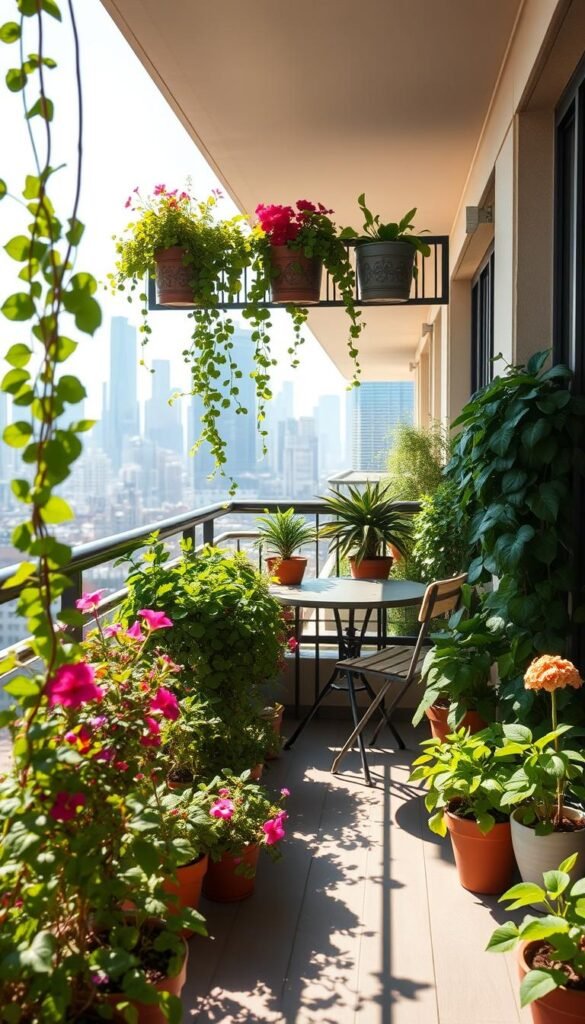
Before you grab your trowel, take time to map out your urban oasis. A little prep work now saves headaches later. Think of it like a puzzle—each piece (sun, airflow, rules) must fit for everything to flourish.
Assessing Your Space and Sunlight Exposure
Start by tracking how sunlight moves across your area. Anne Balogh suggests using a free app or sticky notes to log hourly patterns. Full-sun spots get 6+ hours of direct rays—perfect for cherry tomatoes. Shady corners? Ferns or mint thrive there.
Wind matters too. High-rise dwellers often deal with gusts. Test your setup by hanging lightweight fabric—if it flaps wildly, opt for sturdy pots. Sheltered nooks near walls create microclimates for delicate herbs.
Understanding Building and Weight Restrictions
Check your lease or condo rules first. Many apartments limit pot sizes or ban floor planters. One reader shared how switching to wall-mounted troughs kept their HOA happy while doubling growing space.
Weight distribution is crucial: A 24” clay pot with wet soil can hit 80 pounds. Use lightweight fiberglass or fabric pots instead. Place heavier items near load-bearing walls, and spread containers evenly across the floor.
Selecting the Right Containers and Soil
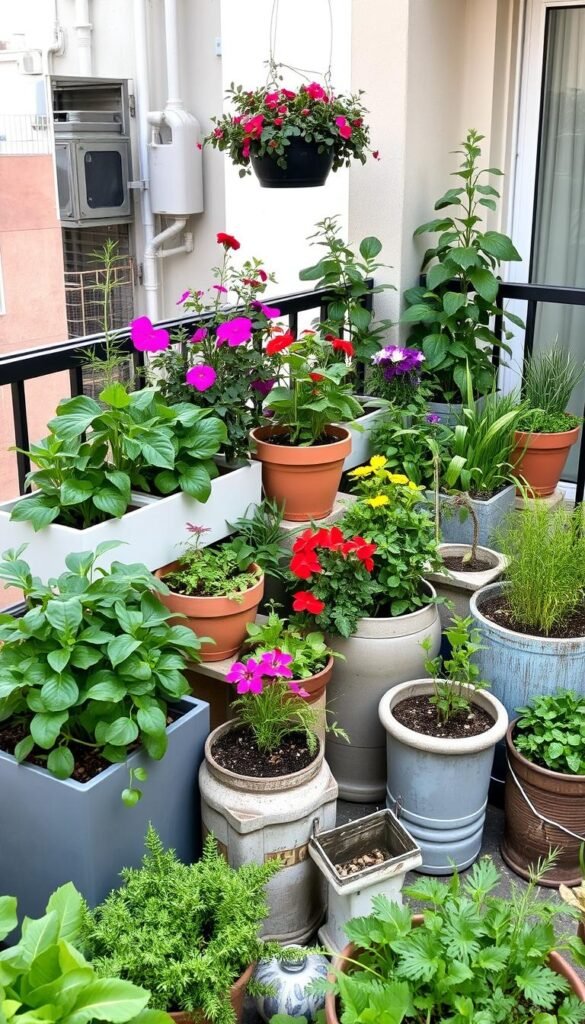
Your urban oasis starts with smart material choices that balance function and style. Lightweight options prevent strain on structures while offering room for creativity. Let’s break down your best bets for thriving greenery.
Smart Picks for Elevated Spaces
Heather McCargo recommends fabric grow bags for root health—their breathability prevents waterlogging. Plastic pots work well for windy spots, while resin mimics terra-cotta’s look without the weight. Consider these factors:
| Material | Weight | Durability | Best For |
|---|---|---|---|
| Plastic | Light | 3-5 years | Herbs, annuals |
| Fabric | Ultra-light | 2-3 seasons | Root vegetables |
| Resin | Medium | 5+ years | Small trees |
Building a Strong Foundation
Premium potting soil makes all the difference. Mix in compost or soak with seaweed water weekly for nutrient boosts. Always check for drainage holes—add pebbles at pot bases if they’re missing.
Apartment dwellers: opt for self-watering containers to reduce maintenance. Pair shallow-rooted greens like lettuce with 6” deep pots, while tomatoes need 12”+. Your plants will thank you with vigorous growth.
Balcony Gardening Basics: Choosing Containers, Soil, and Plants
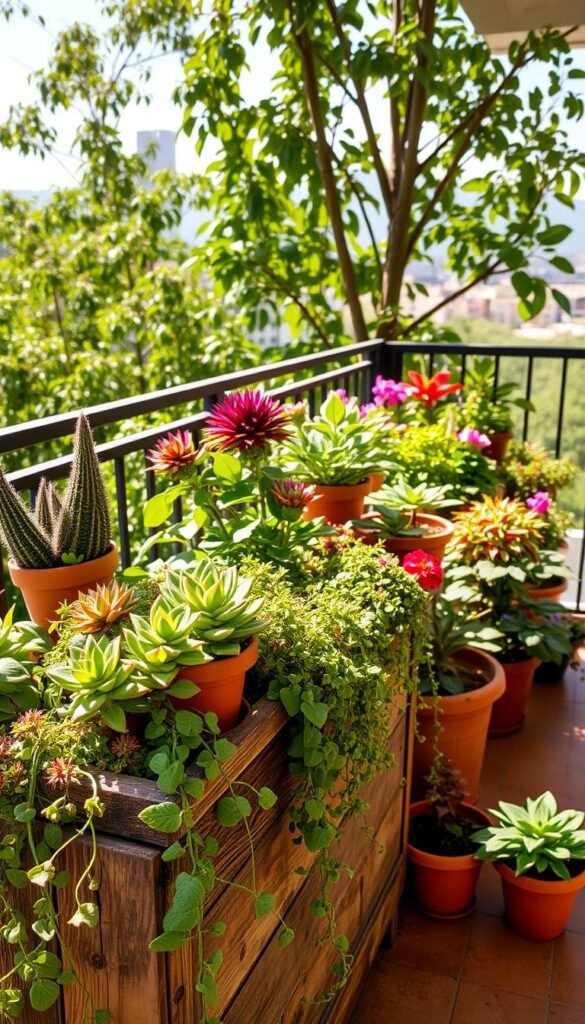
The right greenery can turn your urban space into a vibrant sanctuary. Focus on varieties that adapt to confined roots and shifting weather. Look for compact growth habits, shallow root systems, and resilience to thrive in your unique setup.
Selecting Plants That Thrive in Containers
Prioritize species labeled “dwarf” or “patio-friendly.” Dwarf citrus trees like ‘Improved Meyer Lemon’ yield fruit in 12-inch pots. Herbs such as thyme and oregano flourish with minimal root space. For color, try trailing petunias or compact marigolds.
Check these traits for success:
- Drought tolerance (lavender, sedum)
- Shallow roots (lettuce, pansies)
- Vertical growth (pole beans, snapdragons)
Integrating Native Plants and Edibles
Local wildflowers like purple coneflower attract hummingbirds while needing less care. Mix edible kale with ornamental grasses for texture. “A rosemary bush doubles as a fragrant centerpiece and kitchen staple,” notes urban gardener Lisa Lee.
Try these pairings:
- Tomatoes + basil (pest-repellent duo)
- Native milkweed + zinnias (butterfly magnet)
- Dwarf blueberries + creeping thyme (edible groundcover)
Start small—a pot of mint or nasturtiums builds confidence. Rotate crops seasonally to keep your oasis lively and productive.
Maximizing Vertical and Limited Spaces
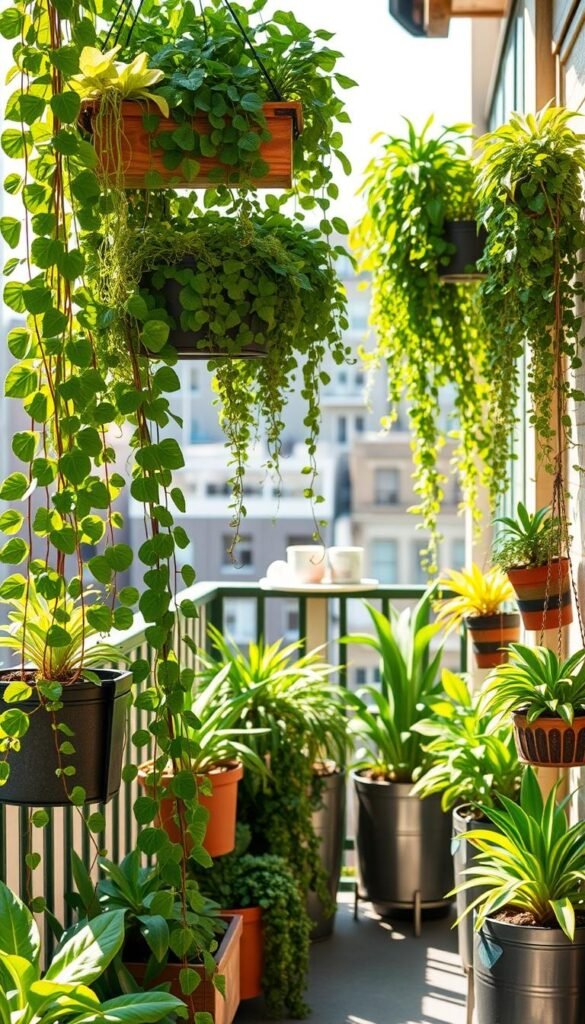
Look up—your vertical space holds untapped potential. Anne Balogh calls walls and railings “the forgotten real estate” of urban growing. By layering greenery upward, you triple planting zones without crowding your floor.
Creative Vertical Garden Solutions
Start with lightweight modular systems. Pocket planters made from recycled fabric let you grow strawberries or succulents in cascading rows. For sturdy surfaces, try magnetic herb boxes that cling to metal railings. Check this comparison:
| Material | Best Use | Examples |
|---|---|---|
| Fabric pockets | Herbs & trailing flowers | Sweet potato vine, thyme |
| Metal brackets | Railing planters | Pansies, dwarf kale |
| Tiered stands | Multi-level displays | Petunias, basil, chives |
Using Railings, Shelves, and Hangers Effectively
Secure window boxes to balcony rails with U-brackets—they’ll hold 15 lbs of soil safely. Floating shelves mounted on walls host compact herb trios like rosemary, sage, and oregano. For breezy spots, hanging macramé holders with spider plants add motion and life.
Mix textures for visual depth: pair sleek metal troughs with woven baskets. Pro tip: Use S-hooks to hang tools or watering cans under shelves. Your once-empty walls now burst with color and purpose.
Caring for Your Balcony Garden: Watering and Maintenance
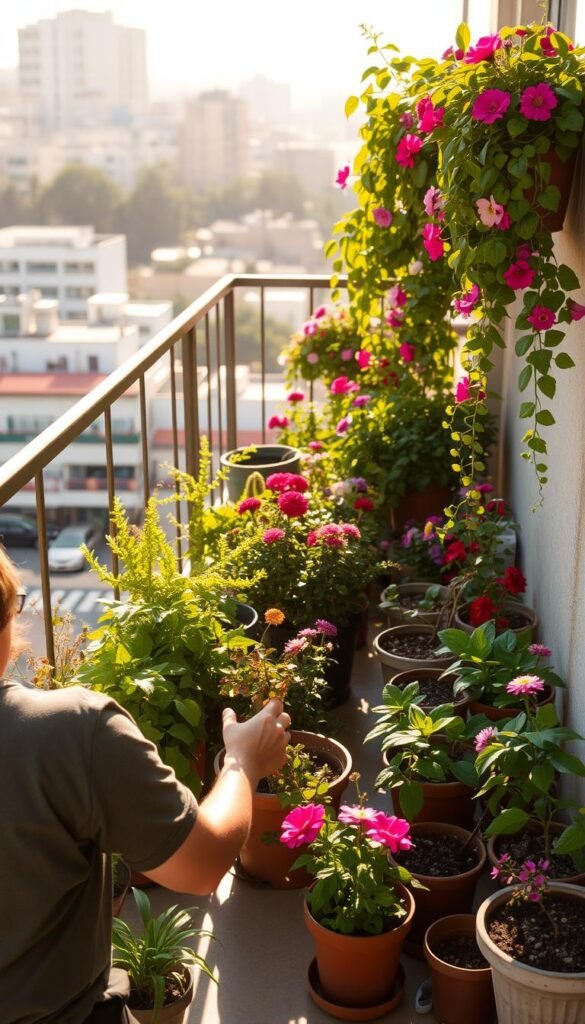
Consistency is your secret weapon for a thriving urban garden. Just like people, plants thrive with reliable care routines that adapt to their changing needs. Let’s dive into simple strategies to keep plants vibrant through scorching summers and chilly winters.
Efficient Watering Techniques and Self-Watering Options
Heather McCargo swears by self-watering containers: “They’re a game-changer for busy urbanites—roots drink what they need without drowning.” Pair these with drip irrigation kits for vacation-proof setups. For traditional pots, water deeply until it drains out—shallow sips encourage weak roots.
Check soil moisture by poking a finger 2 inches down. If it’s dry, it’s time to hydrate. Morning is best—less evaporation means more water reaches roots. In windy spots, add mulch to slow drying.
Seasonal Maintenance and Plant Health Tips
Robin Sweetser recommends swapping fertilizers seasonally: nitrogen-rich mixes in spring, phosphorus-heavy blends for fall blooms. Shield pots from harsh wind by clustering them near walls or using lattice screens as buffers.
Watch for clues: yellow leaves often signal over-watering, while crispy edges mean thirst. Rotate pots weekly so all sides get light—this helps plants grow evenly. When frost threatens, wrap vulnerable containers in burlap or move them indoors overnight.
Set reminders to prune spent blooms and refresh potting mix annually. With these habits, your green haven stays lively year-round!
Wrapping Up Your Balcony Garden Journey
Your journey to creating a green escape begins with small, intentional steps. By matching pots to your space’s conditions and nurturing roots with quality soil, you lay the groundwork for success. Remember: sun-loving tomatoes thrive where shade-tolerant herbs might struggle—always let your light levels guide plant choices.
Don’t underestimate vertical solutions. Wall-mounted boxes or hanging planters maximize every inch while keeping floors clear. Regular watering and seasonal adjustments—like shielding delicate greens from summer wind—help your oasis flourish year-round.
What matters most is starting. A single pot of rosemary or cheerful marigolds can spark joy. As you experiment with compact vegetables or pollinator-friendly perennials, you’ll discover what thrives in your unique environment.
This isn’t just about growing plants—it’s crafting a living sanctuary that reconnects you with nature daily. Whether you’re snipping fresh basil for dinner or watching bees dance among blossoms, your efforts transform concrete into wonder. Ready to dig in?






